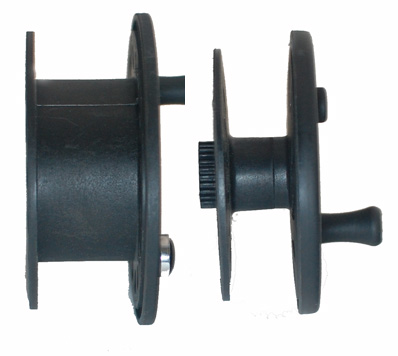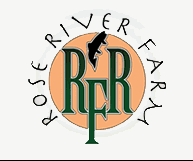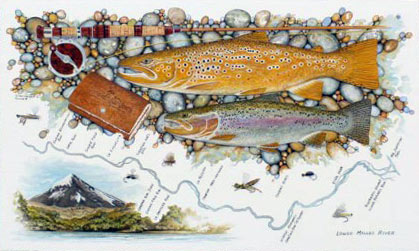Choosing the Right Reel!
Your source for flyfishing and flycraft resources since 1975.
I remember how confusing it was to choose my first fly reel . . . and that was over 20 years ago! Now, there are even more choices in styles, drags, materials and so on. Below, I'll walk you through some of the basics in order to help you decide which would be best for your fishing and budget.
Style: large arbor, mid arbor and conventional arbor
An "arbor" is just the spindle or axle of the spool on a fly reel. The photo on the right shows a large arbor on the left and conventional on the right. You can imagine a mid arbor somewhere in between. Why does it matter? If you're in a fishing situation where getting the line on the reel is important when playing a fish, winding the line on the larger arbor will "pick up" faster. In other words, it'll be easier and quicker to pick up the slack in the line and play your fish on the reel.
This matters mostly when fishing for larger fish where the reel plays an important role in landing the fish. For small fish, say native brookies and bluegills, you'll probably land the fishing without using much of the reel or spooling the line. Even for 18" trout in pools where there's nowhere for the fish to run, we mostly play the fish by hand, not on the reel.
Drag: disc and click (& pawl)
First of all, think of drag on a reel as similar to brakes on a car. A light touch on the pedal and the car begins to slow. If you press hard on the brakes, the car eventually stops. On a fly reel, the drag is simply putting pressure on the turning of the reel in order to make it more difficul for the fish to run. This will aid in your tiring of the fish so that you can eventually land it. A nice smooth drag will also help to protect your tippet from breaking off the fish. In fact, a disc drag is also mechanically similar to automotive brakes as it applies pressure to the turning of the spool and slow the revolution. These are great to use, smooth and infinitely adjustable.
A click drag, which includes the click & pawl, is more like when you were a kid and fastened a piece of plastic to your bicycle frame that made that "clicking" noise when you pedaled. Aside from annoying your parents, it actually made it a bit more difficult to pedal the bike. These usually have only a limited amount of adjustment, but are a classic choice, particularly for stream-sized trout.
So what's best? Again it depends upon your needs and budget. If you're fishing for small fish and hardly use the reel for anything but holding the line, any drag system will be of little or no use. But if you plan to catch fish that are larger or can run (swim) great distances while hooked, a good drag can play an important role in landing the fish.
Materials & Manufacturing: graphite & aluminum
As you can imagine, just about any material could be used to make a fly reel, but graphite and aluminum are the most common because of their availability and weight. Graphite reels tend to be light weight and inexpensive. Because they are often the choice by beginners or in those inexpensive "complete outfits" on the market, they tend to be cheaply made and usually don't last very long if much fishing pressure is put on them.
For aluminum, they can either be cast or machined. Cast reels simply means that the hot metal is poured into a mold, like my mom use to make Jello when I was a kid. It's poured in liquid form, allowed to cool and then voila! You have some sort of Jello structure for dessert or, in the fishing case, parts of a fly reel that may then be assembled.
A machined aluminum reel is when the main parts, spool & frame, are made from a single "chunk" of aluminum. Someone with tools then "carves" away metal until the spool and frame meet specifications. Actually, this is mostly done by computerized machinery, but you get the idea. The tolerances on this type of work can be more exact and much more labor is involved in the manufacture. That's why these cost more money and are consider to be a better product.
Is there a best choice? First, think about what you'll need as a function of the type of fish you'll be catching and then pick a budget. If you're going for tarpon in the Keys, I doubt you'd want to compromise much on the quality of the components and the build. If you're just starting out and not sure whether you'll even like fly fishing, then you might not want to spend much money in the beginning. Remember, it's always fun to trade up in quality once you get the hang of it.
Size Matters: make sure it fits the rod
Your fly rod choice, discussed here, will be of a certain line weight. Just make sure the reel has the capacity to hold the line and some backing that'll work with the rod. Most reels have designations like 4/5/6/, which would be suitable for a 4, 5 or 6 weight rod. A reel that's designed for a 2 or 3 weight won't be big enough to hold a 6 weight line and some backing. By the same token, a reel for a 10 weight will be too heavy too heavy to cast on a 4 weight. Also, the feet of the 10 weight reel probably won't even fit on the 4 weight rod. I can say more, but I'm sure you get the idea.
A lot of discussion centers around the "balance" of a rod and reel combination. If you're starting out, I wouldn't spend to much time thinking about this yet. In fact, I usually just grab a reel & rod that I feel like fishing and don't worry too much about it. A medium weight reel on a medium weight rod will probably work just fine. The most important thing is to get out and fish, not sit at home worrying about balance. If you have more specific needs or wants, it'll become clear as you spend more time with your line on the water!
Final Thought:
Having said all that, most of us like good quality reels that give us confidence when we fish, regardless of the type of fishing. In other words, it just feels good to have a nice reel. I suggest enjoying ones from the different manufacturers as all have their benefits and drawbacks. I call some of the high end reel "fishing jewelry" which is totally fun to fish but, admittedly, totally unnecessary. It's just way fun!






